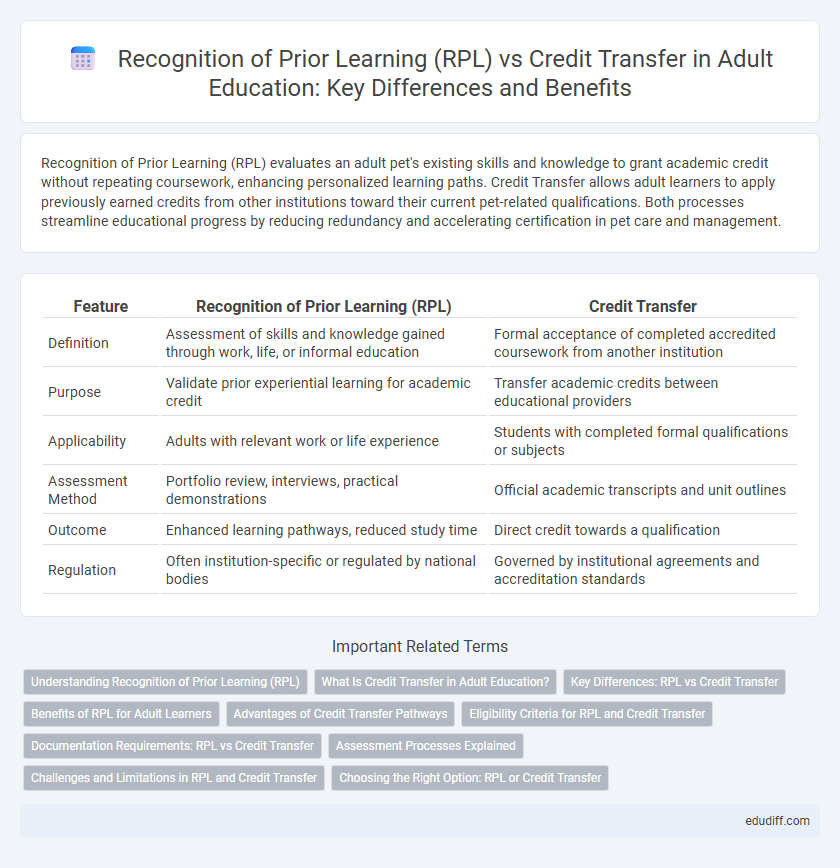Recognition of Prior Learning (RPL) evaluates an adult pet's existing skills and knowledge to grant academic credit without repeating coursework, enhancing personalized learning paths. Credit Transfer allows adult learners to apply previously earned credits from other institutions toward their current pet-related qualifications. Both processes streamline educational progress by reducing redundancy and accelerating certification in pet care and management.
Table of Comparison
| Feature | Recognition of Prior Learning (RPL) | Credit Transfer |
|---|---|---|
| Definition | Assessment of skills and knowledge gained through work, life, or informal education | Formal acceptance of completed accredited coursework from another institution |
| Purpose | Validate prior experiential learning for academic credit | Transfer academic credits between educational providers |
| Applicability | Adults with relevant work or life experience | Students with completed formal qualifications or subjects |
| Assessment Method | Portfolio review, interviews, practical demonstrations | Official academic transcripts and unit outlines |
| Outcome | Enhanced learning pathways, reduced study time | Direct credit towards a qualification |
| Regulation | Often institution-specific or regulated by national bodies | Governed by institutional agreements and accreditation standards |
Understanding Recognition of Prior Learning (RPL)
Recognition of Prior Learning (RPL) evaluates an individual's existing skills and knowledge gained through work experience, informal training, or life experience to grant formal qualifications, streamlining the education process. Unlike Credit Transfer, which acknowledges previously completed formal coursework, RPL assesses competencies regardless of where or how they were acquired, making it a flexible option for adult learners. This approach enhances access to education by validating diverse learning pathways, reducing redundancy in training, and accelerating career progression.
What Is Credit Transfer in Adult Education?
Credit Transfer in adult education allows learners to apply previously earned academic credits from accredited institutions toward their current qualification, reducing the time and cost required for program completion. This process recognizes formal learning achievements and ensures they align with the curriculum requirements of the new program. Credit Transfer supports adult learners by providing a streamlined pathway to earn credentials based on validated prior coursework.
Key Differences: RPL vs Credit Transfer
Recognition of Prior Learning (RPL) evaluates an individual's existing skills and knowledge gained from work or life experiences to award formal qualification credits, while Credit Transfer grants credits based on previously completed accredited courses. RPL involves assessment and validation of informal or non-formal learning, whereas Credit Transfer relies on documented evidence from recognized educational institutions. The core difference lies in RPL's flexibility to recognize diverse learning pathways, contrasting with Credit Transfer's dependence on formal academic records.
Benefits of RPL for Adult Learners
Recognition of Prior Learning (RPL) enables adult learners to gain formal qualifications by validating their existing skills and knowledge, reducing the time and cost of education. Unlike credit transfer, which applies only to previously completed accredited courses, RPL acknowledges informal, non-accredited experiences, enhancing access to higher education and career advancement. This process supports lifelong learning by valuing diverse experiences and accelerating pathway progression for adults re-entering education or changing careers.
Advantages of Credit Transfer Pathways
Credit Transfer Pathways offer significant advantages by enabling adult learners to capitalize on previous academic achievements, reducing the time and cost required to complete new qualifications. This streamlined process enhances accessibility and flexibility, allowing learners to seamlessly integrate prior accredited credits into their current study programs. The efficiency of credit transfer supports lifelong learning and promotes higher education progression by minimizing redundant coursework.
Eligibility Criteria for RPL and Credit Transfer
Recognition of Prior Learning (RPL) eligibility requires individuals to provide evidence of relevant skills and knowledge gained through informal, non-formal, or work-based learning without completing formal assessments. Credit Transfer eligibility necessitates prior completion of equivalent formal units or courses recognized by the institution, ensuring direct substitution for required curriculum components. Both processes support adult learners by acknowledging existing competencies but differ in documentation and assessment requirements for validation.
Documentation Requirements: RPL vs Credit Transfer
Recognition of Prior Learning (RPL) requires comprehensive evidence such as portfolios, work samples, references, and detailed statements demonstrating skills and competencies gained outside formal education. Credit Transfer demands official academic transcripts and course outlines from previously completed qualifications to verify equivalency and directly apply credits towards a new qualification. Proper documentation is essential for both processes to ensure accurate assessment and validation of prior learning or completed courses.
Assessment Processes Explained
Recognition of Prior Learning (RPL) assesses an adult learner's existing skills and knowledge through evidence demonstration, while Credit Transfer evaluates previously completed formal qualifications for exemption from current course requirements. The RPL assessment process involves skills audits, portfolio reviews, and competency evaluations tailored to individual experiences, whereas Credit Transfer requires verification of accredited transcripts and alignment of prior coursework with the new curriculum. Both processes streamline adult education pathways but differ in assessment techniques and sources of validation.
Challenges and Limitations in RPL and Credit Transfer
Recognition of Prior Learning (RPL) faces challenges such as inconsistent assessment standards, difficulties in verifying informal or non-formal learning, and limited access to quality evidence from diverse learners. Credit transfer struggles with compatibility issues between institutions' curricula, variations in credit value and course content, and administrative complexities that delay or hinder seamless credit acceptance. Both processes often encounter limitations due to lack of standardized policies, resulting in reduced mobility and recognition for adult learners.
Choosing the Right Option: RPL or Credit Transfer
Choosing between Recognition of Prior Learning (RPL) and Credit Transfer depends on individual educational background and career goals. RPL assesses existing skills and knowledge to award credit without formal coursework, which suits professionals with extensive practical experience. Credit Transfer applies to completed academic units from recognized institutions, streamlining progression in structured programs and ensuring seamless credit accumulation.
Recognition of Prior Learning (RPL) vs Credit Transfer Infographic

 edudiff.com
edudiff.com